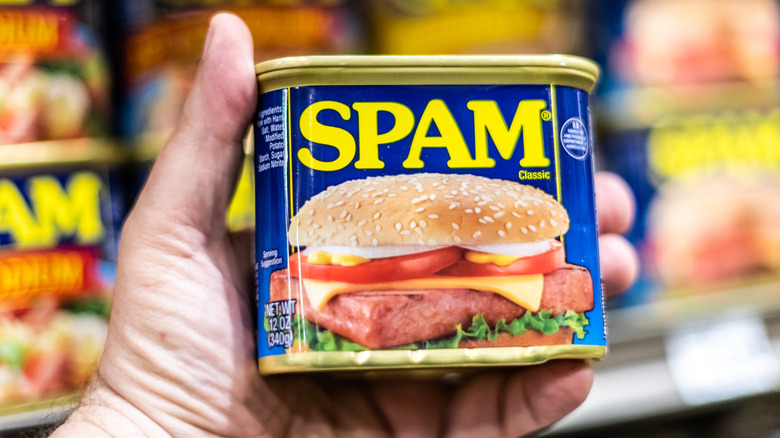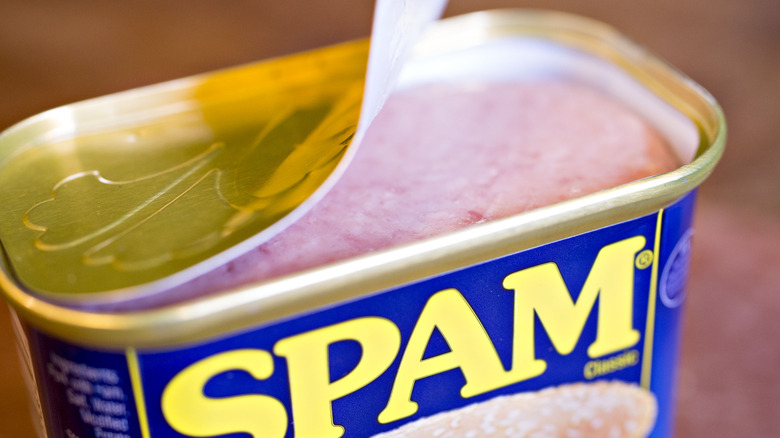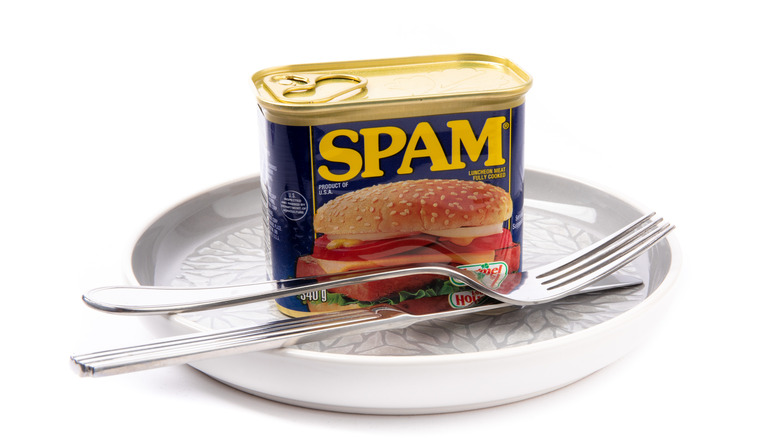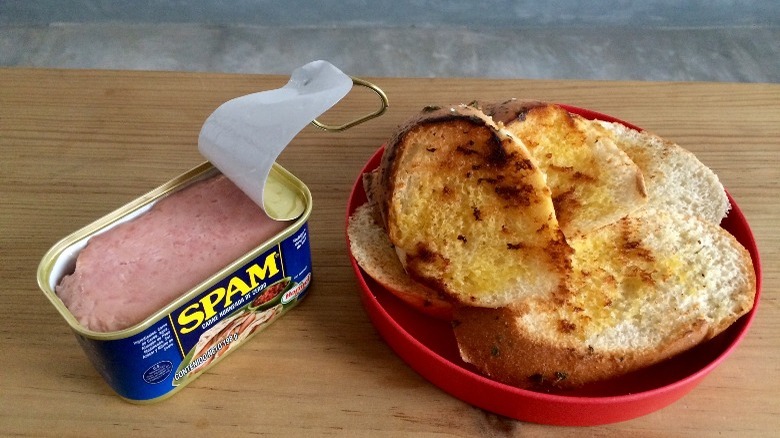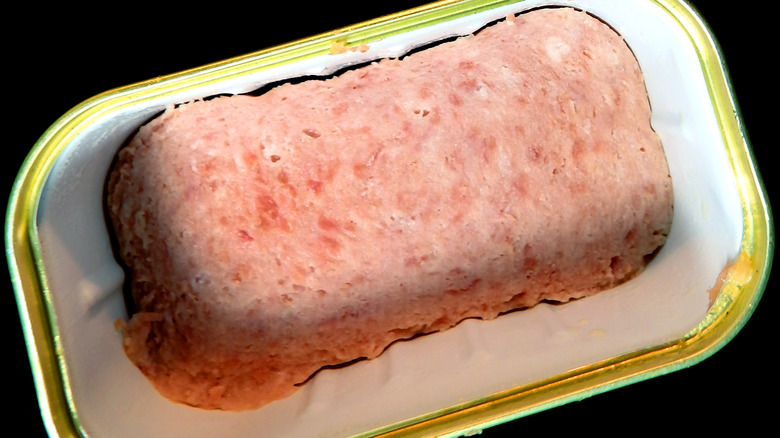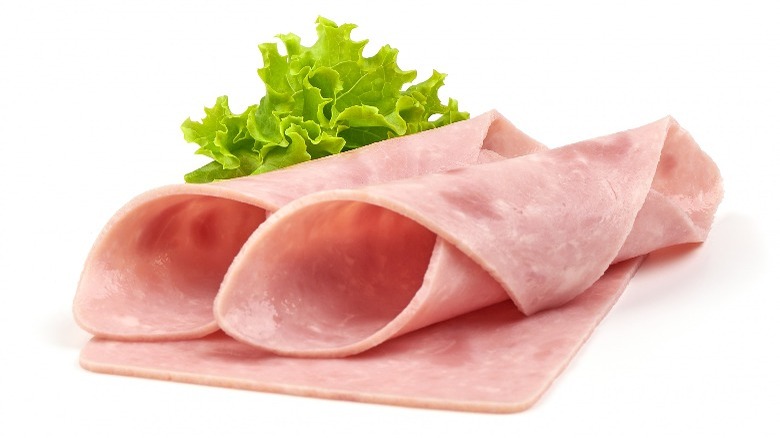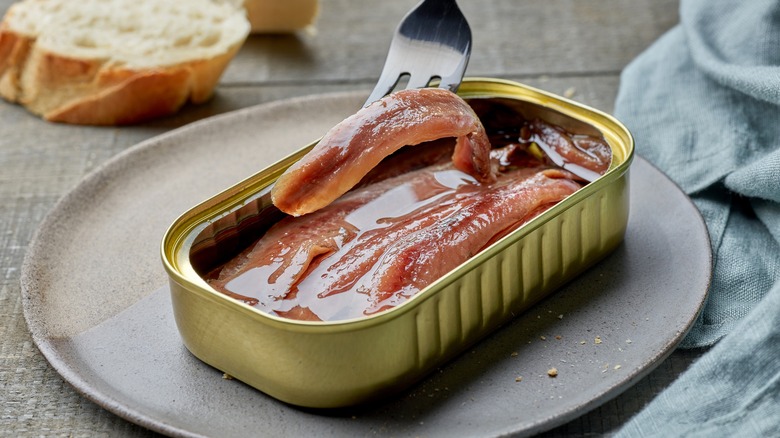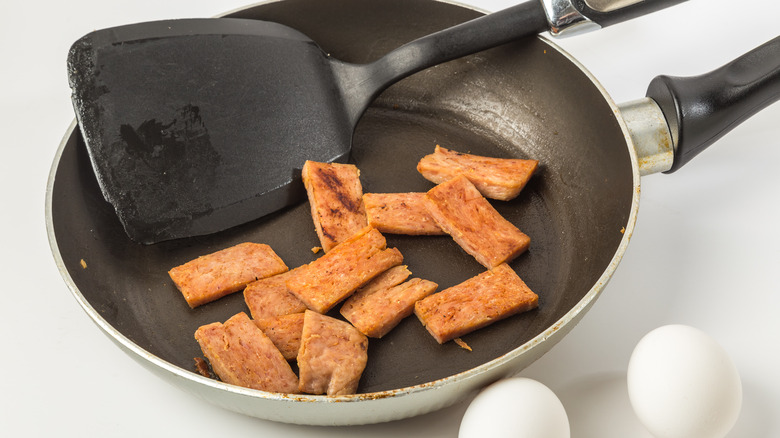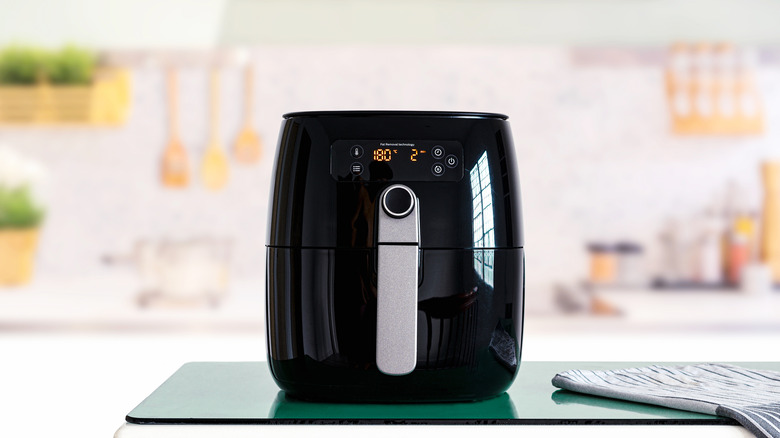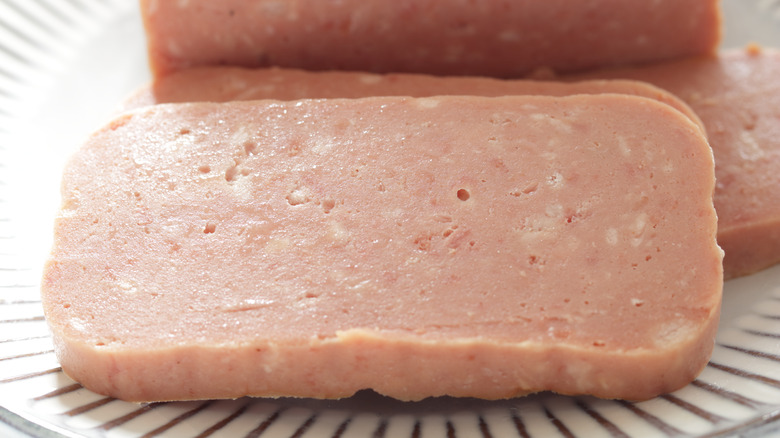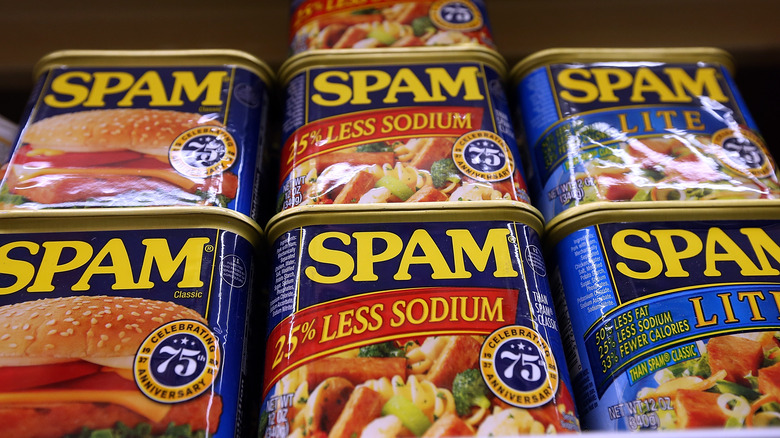Mistakes Everyone Makes While Cooking Spam
Spam: It's one of the world's most controversial foods. Some absolutely love its saltiness and slightly slimy texture. Others are deeply turned off by the food's seemingly endless shelf life. But if you are willing to dive into the deep end of Spam's culinary abilities, you need to make sure you're handling the ingredient properly. By making common Spam-cooking mistakes, you're likely to be left with a sad, soggy artificial meat slice that's basically inedible. However, when you cook your Spam the right way, you'll be blessed with a crispy, deliciously umami, and meaty accent that can pair beautifully with a wide variety of foods.
If you're not too well-acquainted with cooking with Spam, you've come to the right place. We've compiled a list of some of the most common Spam-cooking traps people fall into. By reading up on these potential errors and making sure you don't make them in your own kitchen, you can ensure you always enjoy your Spam. Whether it's something you eat on the regular or it's a rare treat to enjoy when you're ready to indulge, let's make sure you never mess up another serving again.
Thinking you have to cook it at all
If you want to make sure you're not making yourself sick, you're probably never going to attempt to eat raw meat. But does that mean you have to cook Spam completely through before you ever taste a bite? You may be surprised to know that this is not the case. That's because, according to Healthline, Spam is already cooked before it even makes its way into the can. Therefore, you can technically eat it without cooking it at all, and it's not going to make you sick. This can come in handy if you're camping or in another situation where cooking is difficult.
However, that doesn't necessarily mean you should eat uncooked Spam out of the can all the time. Most people seem to agree that it tastes better when it's been warmed up, and we like it when the edges get crispy, adding a bit more texture to the mix. That's totally a preference though. If you want to eat Spam without cooking it, go ahead and be our guest. It's already cooked through, so food poisoning shouldn't be a concern.
Cooking it in the can
It should go without saying that you should first take your Spam out of the can before you cook it. Take if from one Boy Scout, who attempted to make one of his favorite foods during a camping trip. Dan Human of Delishably once wanted to make Spam while cooking over an open fire. Originally, Human had planned on using a pan, just like he did at home. But then a camper told him that he could prevent a mess by simply cooking the Spam in the can over the fire. As you can imagine, placing an unopened can of sweating meat over a fire is going to result in just one thing: a meat explosion.
Although Spam may be an incredibly versatile food, you do, in fact, need to take it out of the can before you attempt to cook it. While this may not be the most common Spam-cooking mistake, we're almost certain than Human isn't the only person who's made it before, so it's worth mentioning. Cooking Spam over an open fire while you're camping? Highly encouraged. Cooking it in the can? Unless you're trying to get showered with hot, salty, processed meat, don't bother.
Thinking you have to eat it up right away
You're not going to want to leave most types of meat sitting around for long before eating it, or you might get sick. But when it comes to Spam, you don't have to worry about this as much. That's because, according to Primal Survivor, Spam's "best by" date is generally about three years from when it was manufactured. So, provided the can hasn't been damaged or opened in any way, you can keep a can of Spam for a long time. You're probably even fine to eat the stuff after the best by date has passed, though it may not taste as good as "fresh" Spam does. This is one of the reasons why Spam is often viewed as a good survival food. Whether you're going camping or preparing for nuclear disaster, there's a good chance that Spam will come in handy.
But what about once you open it? Per Eat By Date, you don't even have to use it up too quickly after you've opened the can: It should last sealed, in the refrigerator, for around seven to 10 days. Therefore, even if you live alone and don't generally go through a ton of meat in a week, you don't have to force yourself to incorporate leftover Spam into recipes where it doesn't work.
Not refrigerating open Spam cans
Just because you can keep Spam around for a long time before you use it up doesn't mean you can just leave it sitting out on your counter for days at a time. Just like with any other meat, this makes you liable to foodborne illness. Spam isn't as likely to spoil as quickly as other types of meat due to its high concentration of sodium nitrate and salt, per Survival Freedom. These ingredients act as preservatives, which keep your Spam "fresh" for longer. However, it's still important to refrigerate Spam once you've opened the can if you don't use all of it in one recipe.
This is a pretty easy mistake to avoid since you (hopefully) refrigerate all of your unfinished food anyway. But considering the fact that Spam is beloved for its shelf-stability, it's worth mentioning in case you forgot to put your Spam in the fridge and you're wondering if it's okay to eat it the next day. In that case, you're better off just trashing it.
Slicing it too thin for a sandwich
While Spam isn't the worst processed food you could eat, there are some concerns about how healthy it is, per Healthline. This may lead some to slice their Spam exceptionally thin — as if it were a cold cut — when preparing it for a sandwich. While it's admirable to keep your health in mind, if you want to get the full Spam experience, it should be the star of the show. You don't want the meat to get overpowered by the other ingredients.
According to What's Cooking America, you'll want to slice your Spam about a quarter-inch thick if you're using it for Spam musubi, the Spam-meets-sushi snack that's become a staple of Hawaiian cuisine. We also think the same principle applies if you're frying it up for a sandwich. This is enough Spam to give you just enough flavor to complement your other ingredients.
Slicing it too thick for a sandwich
While slicing your Spam too thin definitely isn't a good idea, you're still not going to want to slice it too thick either. Since Spam is so salty, it has a pretty intense flavor. It's also very fatty, so getting a huge bite of the stuff might give you that strange feeling that you've got a layer of oil coating your mouth. Again, you're going to want to stick to that quarter-inch guideline if you're trying to make the best possible Spam sandwich. Much more than that, and you'll likely go into Spam overload before that plate is empty.
Of course, this is a matter of personal preference, so if you want to slap a brick of Spam onto your sandwich, by all means, go right ahead. However, if you're looking for more of a balanced flavor profile, don't make those slices too thick.
Pairing it with other salty ingredients
When you're cooking meats like chicken, beef, or shrimp, you may love adding super-salty ingredients like anchovies or olives into the mix. Salt gives meat (and nearly any dish) an extra layer of flavor that makes them even more appetizing. However, it's important that you don't treat Spam like fresh meat, as its sodium content is already so high. If you were to add salty ingredients to your Spam dishes, you'd likely be making your food way too salty.
According to Healthline, a serving of Spam contains 32% of the recommended daily intake of sodium. Spam already has a lot of flavor, so don't think that you have to add other salty ingredients to further season it — in fact, the Spam is going to end up seasoning the other ingredients. If you want to add salt or other salty ingredients to the mix, be sure to take it slow and taste as you go. Otherwise, the end result may be too salty to truly enjoy.
Crowding the pan
One mistake that people all too commonly make when they're searing Spam (and a lot of other foods) is crowding the pan. According to Cooking Clarified, this can result in less-than-desirable results for many different foods. But when it comes to Spam, it's especially important not to crowd the pan since getting it nice and crispy is essential to so many recipes. So, what's wrong with crowding the pan? The more you add to your pan, the more it lowers the cooking temperature. Even if you start off with a really hot pan, adding to much Spam to it (especially Spam that's been refrigerated) can significantly slow the cooking process.
But there's another problem with crowding your pan with Spam. If you have layers that are covering each other, moisture is going to get trapped between them. All of this moisture makes it harder for your Spam to crisp up properly. Therefore, if you have a lot of Spam to cook, make sure you do so in batches.
Cooking it in oil
If you know one thing about Spam, it's probably the fact that it's loaded with fat. Take one bite, and you'll immediately get a sense of just how fatty it is. And though you can always opt for Spam Lite (which has 50% less fat), most people are going to be cooking with the original stuff. If that's the case, then you're going to want to remember that you don't have to add any oil to the pan, per Food52.
Plop some Spam into a pan, and you'll notice that some of that fat is released right away. All of that rendered fat will prevent the meat from burning in the pan, negating the need for oil. Adding much oil at all is likely to make your Spam too greasy, to the point that it starts to taste unappetizing. Therefore, you can forget the extra step of adding oil to your pan; your Spam will cook and taste just fine without it.
Not trying it in an air fryer
For those who want to explore new ways to cook Spam, air frying the stuff is a great idea. Because it's already so fatty, this canned meat doesn't have a hard time crisping up regardless of how you cook it. But when you put it in the air fryer, the machine takes the crispiness to a whole new level. Plus, we love that it's a super-easy, no-fuss method. According to Cooking Perfected, you won't have to spend longer than about 10 minutes preparing your Spam in the air fryer. Not only does it get the job done quickly, but it's also less messy.
One thing to remember: Just like you don't want to crowd the pan when you're frying Spam in a skillet, you don't want to crowd the air fryer basket. Your Spam will get its crispiest when you lay it down in a single layer.
Not soaking your Spam before preparing it
Ever feel like Spam is just too salty to really enjoy? Well, we have a solution for you, and luckily, it's incredibly easy. According to Natural Gourmet Institute, all it takes is a bit of water to wash away a lot of the salt content. Simply soak your Spam in cool or cold water before cooking it; change the water several times during this process for the best results. If you're in a rush, try simply rinsing the Spam in the sink. If you want to get even more of the salt out, try boiling your Spam before you cook it. Whichever way, you'll need to pat it dry before attempting to fry it.
Other ways to make Spam taste less salty include pairing with potatoes (which can handle a lot of salt) and pairing your Spam with something acidic, like lemon juice or apple cider vinegar. Vinegar and oil complement each other exceptionally well, and fat and acidity is a winning combo with Spam, too.
Only cooking with original Spam
We get it: Spam is a classic, and there's a good chance that most of the times you've eaten the product, it was the plain old stuff you've always had. But did you know that there are actually a wide variety of Spam flavors on store shelves? The classic option is always great, but if you're looking for something on the lighter side, you might want to opt for Spam Lite or Spam Less Sodium.
Those who are looking for a slightly different flavor profile can try the Hot and Spicy Spam or go for the jalapeño-flavored stuff. It's not particularly spicy, but we think the extra layer of flavor can add a lot of interest to whatever dish you're making. Spam Teriyaki is a great choice when you want a richer flavor, and the Portuguese sausage variety gave us an experience we never even knew we wanted.
Next time you go to the canned meat aisle to pick up a can of Spam, don't just settle with the flavor you've always experienced. Switch it up and try something different, and you might just find that you have a brand-new favorite.
